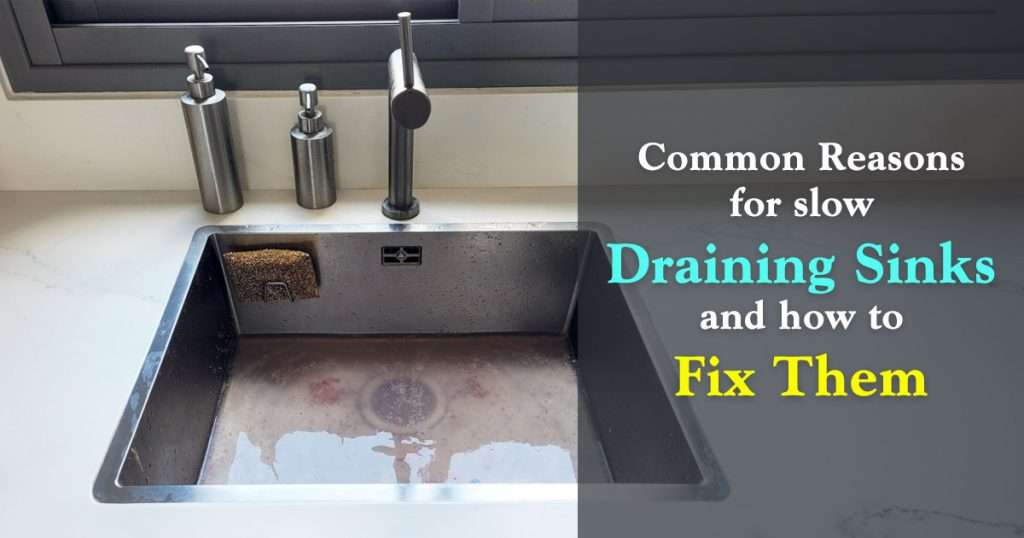Is water taking longer than usual to drain from your bathroom or kitchen sink? A slow drain is a common problem for homeowners. It might not seem like a big deal, but if you ignore it, you could end up with bigger issues like water overflow, bad smells, and even water damage.
The good news is that you can often fix a slow-draining sink on your own without needing to call a plumber. See 10 common reasons why drains get slow and easy solutions to get your sink back to normal.
1. Hair Accumulation
Hair accumulation is a frequent culprit, especially in bathroom sinks. Over time, hair can build up in the drain, creating blockages that slow down water flow.
To fix a slow drain, regularly remove hair from the sink drain. Use a drain snake or a hair-catching device to keep the drain clear. If the blockage is serious, a solution of baking soda and vinegar can help dissolve the hair and clear the drain.
2. Soap Scum Buildup
Soap scum, a residue left from soap and water, can accumulate in your pipes, reducing the diameter and slowing water flow. To progressively unclog a bathroom sink drain, pour a mixture of hot water and vinegar down it regularly. For stubborn buildup, a specialized drain cleaner may be necessary. Ensure you choose one that’s safe for your pipes.
3. Food Particles
In kitchen sinks, food particles can get washed down the drain and cause blockages, especially if you don’t have a garbage disposal. Avoid pouring large food particles down the drain. Utilize a sink strainer to collect food particles and clean it regularly. If your kitchen sink is already draining slowly, use a plunger or drain snake to clear the clog.
4. Grease and Fat
Grease and fat can solidify in your pipes, leading to blockages that slow down your kitchen sink’s drainage. Never throw grease or lard down a slow drain to get it cleared. Instead, place it in the garbage. To remove grease clogs, first pour boiling water down the drain, then a mixture of baking soda and vinegar.
5. Mineral Buildup
In hard water areas, minerals can accumulate inside the pipes, decreasing water flow. To deal with a slow-draining sink, consider adding a water softener to decrease mineral buildup. For existing buildup, use a commercial descaling agent designed for plumbing systems. Regular maintenance can prevent severe blockages.
6. Foreign Objects
Small objects like jewelry, toothbrushes, and toys might accidentally fall into the sink and cause clogs. When this occurs, use a drain snake or another piece of similar equipment to extract the object. For hard-to-reach items, you may need to remove the P-trap beneath the sink. Always cover the drain when cleaning or handling small items near the sink.
7. Improperly Installed P-Trap
A poorly installed or damaged P-trap can lead to drainage issues. Inspect the P-trap for any misalignment or damage. If you’re unclear on how to fix it, call a plumber. To avoid future issues, ensure that the P-trap is securely placed and properly connected.
8. Ventilation Issues
Plumbing systems need proper ventilation to allow water to drain smoothly. A blocked vent can cause slow drainage. Check for vent blockages by looking at the vent pipe on your roof. If you suspect a blockage but can’t see it, call a professional plumber. Regular maintenance of your plumbing vents can help prevent these issues.
9. Tree Roots
Tree roots can grow into your sewer lines, causing blockages and slow drainage throughout the house. If you suspect tree roots are the cause, you’ll need a professional plumber to inspect and clear the lines. In serious instances, you may need to replace the compromised pipes and take precautions to avoid future root intrusions.
10. Corroded Pipes
Pipes can corrode with time, particularly if they are composed of ancient materials such as galvanized steel. Corrosion can restrict water flow. To clear the sink, try inspecting your pipes for signs of corrosion. If your pipes are old and corroded, they might need to be replaced. Consult a professional plumber to evaluate the condition of your pipes and recommend the best course of action.
How to Prevent a Slow-Draining Sink
Preventing slow drainage issues can save you from the hassle of dealing with blockages and costly repairs. Here are some preventive measures you can take:
- Regular Cleaning: Regularly clean your drains with a mixture of hot water and vinegar to prevent buildup.
- Use Drain Screens: Put drain screens in your kitchen and bathroom sinks to collect hair, food, and other debris.
- Proper Disposal: Dispose of grease, fat, and large food particles in the trash, not down the drain.
- Avoid Chemical Drain Cleaners: While they are useful, regular usage can harm your pipes. Whenever feasible, choose natural solutions.
- Routine Maintenance: Have a skilled plumber evaluate your plumbing system regularly to detect and resolve concerns before they become serious.
Effectively Fix Your Slow Drain Using This Guide
Dealing with a slow-draining sink can be frustrating, but knowing how to fix and prevent these issues can help. Whether it’s your bathroom or kitchen sink, understanding the causes and solutions will keep your sinks working well.
Following these tips and taking preventive measures will ensure your sinks drain smoothly. Regular maintenance and correct disposal are essential for avoiding typical drainage problems. If you’re unsure or have recurrent problems, go to a professional plumber. With these strategies, you can clear a slow drain and avoid future challenges.

